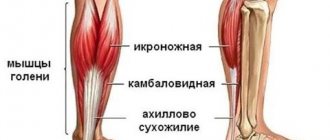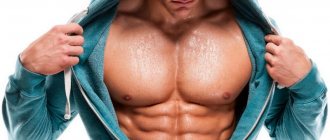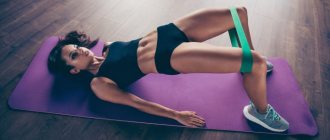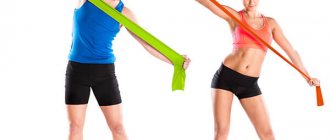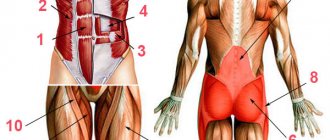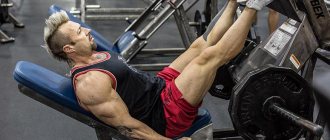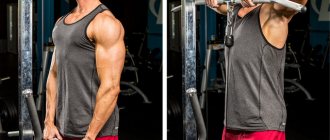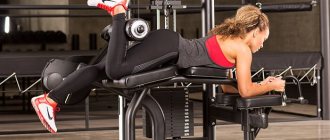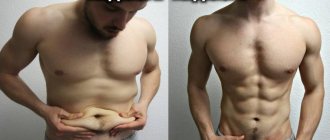Hello, dear readers!
It often happens that even with constant training, the calf muscles are far from perfect and noticeably lag behind other muscles, for example, the biceps. In bodybuilding, since the time of competition among natural athletes, it has been customary to take equality of coverage of the lower leg, biceps and neck as the standard of proportional development. In this article, I will tell you how to pump up your lower leg if it lags behind the standard, and I will offer an example of a targeted training program for this muscle group. It happens, of course, that physiological characteristics are an obstacle to creating beautiful lower leg muscles, although usually the fault lies with omissions in planning the training process.
The shins are often called calves. To distinguish between these terms, let's take a short excursion into anatomy.
Anatomy
The calf muscles are located on the tibia and fibula bones. These include several muscles, but the main muscles we need to focus on are the tibialis anterior and the triceps surae.
The tibial muscle is located on the outside of the tibia and can be easily felt. It is involved in extension of the foot and in its supination.
The triceps muscle is located on the back of the lower leg. From its name it is clear that it consists of three heads, two of them make up the superficial part of the muscle, which is called the gastrocnemius. The deep bundle of the triceps muscle is quite voluminous. It creates a massive look to the shin and is shaped like a fish. Hence the name - soleus muscle.
In the gastrocnemius and soleus muscles, the slow (oxidative) type of fibers mainly predominates. They are inclined to long-term aerobic work. In addition, they have very high explosive power. All weightlifting movements are primarily performed with the help of sharp extension of the foot.
For any muscle to hypertrophy, stress must be created. So how do you build it for explosiveness and endurance in your calf muscles?
From theory to practice: the best exercises for the calf muscles
In order to pump up your calves on your legs as effectively as possible, while also using other muscles, you need to understand the technique of performing various exercises. Calf exercises will be most beneficial if you follow the instructions carefully and don't push them too hard.
Calf raises in the gym
For those who know at least a little how to pump calves, this exercise is a classic. It is used very often, and it bears fruit. When starting to perform, stand with the exercise pads on your shoulders. Feet stand shoulder-width apart, we do not rest on the entire foot, but only on its pads.
Try to keep your knees slightly bent to protect your joints from injury. Keep them in this position while performing.
Slowly lower yourself down until your heels almost touch the floor. Try not to lower your legs completely to give more load. Return to the starting position when you feel that the calf exercise has resulted in a noticeable stretch in the muscles. Tighten your calves extra for maximum effect.
During execution, you should avoid straining your toes. Also try not to sway when your body is at its lowest point. This makes the exercise almost useless. A steady pace and slow repetitions are the key to success.
If you don't have a calf raise machine at your disposal, try a free weight version of the exercise. A barbell plate or dumbbell will do.
Seated calf raises
Another great exercise for those who want to know how to quickly pump up their legs. The main emphasis in it is on the soleus muscle, which, with proper training, gives the lower leg greater width and thickness.
A trainer is required to perform this. Sit with his pillows on your lap. There is no need to place them on your hips. The feet are placed on the lower platform, the legs are positioned shoulder-width apart. Without swinging your legs, lift them onto your toes. At the top point, additionally tighten your shin. Do the movement in full amplitude without lowering your foot completely onto the platform.
In case of its absence, a barbell can replace this simulator. To avoid discomfort when performing, you can wrap the bar with a cloth or put a towel on your feet. Place weights under your feet and place the barbell on your thighs just above your knees. It is best to ask your partner about this, so you can avoid traumatization.
Calf raises on a bench press machine
An excellent option for athletes wondering how to pump up their calf muscles. It is ideal for gaining weight. It is performed in a leg press machine, with an angle of 45 degrees most often chosen.
The correct technique involves maintaining a 90-degree angle at the hips. This way you will achieve maximum stretching of the calf muscles. Exercises for the calves are effective when there is a large range of motion, and this exercise guarantees it.
Sit in the machine with your feet shoulder-width apart. Do the movements slowly: lower the weight, stretching the muscles of the lower leg, then lift it to contract the muscles.
Don't be overweight. If you can't do a set with maximum amplitude, then you need to reduce the load a little. The trick is to choose the weight so that there is a balance between the load on the muscles and the range of their movement.
Single leg raises
How to pump up your calves at home, without using exercise equipment? Just do single-leg calf raises. This version of the exercise is even more effective than its variation for both legs. With its help, you can evenly gain muscle mass in your legs.
To perform this you will need an additional load in the form of a dumbbell. At the initial stages of training, you can do it without weights to adapt the muscles to intense work.
When using additional weight, it must be kept on the side of the working leg. With your free hand, grab a stable support and begin the exercise. The technique is the same: stretch your calves as much as possible, it is advisable not to sit on your heels.
Often one of the legs is slightly behind the other in strength. You can quickly build up your legs by doing a few extra reps on your weak leg. Overcome yourself and do them through strength.
Heel raises
The question of how to pump up your calves quickly sounds incomplete. Many athletes forget that in addition to these muscles, there are others located on the front of the lower leg. But they are also important if you want to get the ideal shape of your legs.
You can pump up this part using heel raises . By practicing them, you can strengthen your shins and make them more resistant to injury.
In the first stages of training, you will not need additional weights. Often these muscles are quite weak, so your own weight is enough.
Stand straight with your feet shoulder-width apart. Place your heels on the stand with your feet down. Rise up on your heels, stretch your toes up. Try to avoid rocking.
Aerobic calf training
The calf muscles work well during prolonged aerobic exercise, such as walking, running, and cycling. When exercising on an exercise bike, you need to pay attention to the correct placement of your feet on the pedals and the range of motion. The main support should be on the balls of your feet, and the distance from the seat to the pedals is selected individually. The range of movement should allow almost full extension of the foot. It is necessary to select a load at which it is possible to maintain 80-85 rpm for at least 30 minutes. The lower leg muscles can be worked out perfectly on the ellipse and stepper. Modern cardio equipment also includes a jump rope, which specifically loads our target muscles.
Exercises for pumping up calves
To pump up your calves, you don’t have to go to the gym; you can do it at home. Let's look at the main options for shin exercises to perform at home and in the gym.
Standing calf raise
Stand with your toes on the edge of a platform 5-7 cm high, lowering your heels to the floor. Take a dumbbell or other weight in your lowered hand. Hold the vertical support with your other hand. Rise on your toes to the maximum possible height, holding the top position for 1-2 seconds, and then lower down, touching your heels to the floor. It is important to follow the correct technique when performing this exercise. Main mistakes:
- When lifting, you help yourself with your trapezius, lifting your shoulders up. You can’t do this because it takes some of the load off your shins.
- You bend your knees, driving your heels down, and fully straighten your knees at the top of your calf raise. As a result, other leg muscles are involved in the work, and the lower leg is poorly developed.
To avoid making these mistakes, don't use too much weight that causes you to break your technique. It's better to take a lighter weight and make sure that your shoulders do not rise and your legs remain straight throughout the exercise.
Seated calf raise
This exercise is performed while sitting in a machine, it loads the soleus muscle. Choose a load so that you can perform no more than 10-12 repetitions. Lower your heels into a low position, stretching the back of your shins. Raise your feet on your toes, overcoming the resistance of the mechanism. At the top point, freeze for 1-2 seconds, then slowly lower your heels down.
You can do this exercise at home with your feet on a block and a weight on your knees. The mass of the load should be large enough, since due to the sitting position, the weight of your own body does not create a load on the lower legs. You can sit on your partner's lap.
Calf raises in a hack machine
Step into the Hackenschmidt machine, setting the weight that suits you. Lower your heels, stretching the back of your shins. Rise onto your toes, overcoming the resistance of the machine, pause at the point of maximum lift and smoothly lower to the starting position. This exercise works all three heads of the triceps muscle at the same time.
"Donkey"
This exercise can be done with a partner or in a machine. In the first option, you stand with your toes on an elevated platform, rest your hands on a horizontal support and bend over without bending your knees. A partner sits on your lumbar area, creating a weight. Then you rise onto your toes, as in the previous exercises. Try to keep your legs straight throughout the set. In gyms, to perform this exercise, a special machine is used that creates a load in the lumbar region.
Leg press
You can also use the platform bench press to pump up your calves. But you don’t need to bend your legs deeply, as when doing hamstring exercises. Stop in the initial bending phase and straighten your legs. returning the platform to its place. Such a low-amplitude press will allow you to pump up your calves well.
Success in pumping up calves largely depends on genetic characteristics. For some, the calf muscles grow even from basic leg exercises, while others, in order to pump up their calves, have to work for a long time to work out this area, getting a very modest result. But if you use our recommendations and pay attention to working out the calf muscles 2-3 times a week, alternating high-intensity multi-repetition training and strength exercises with a number of repetitions of 8-12, plus apply such types of aerobic exercise as running up stairs, jumping jump rope, then the result will definitely be.
Anaerobic (strength) training
In addition to cyclic types of load, the lower leg responds well to strength work in the gym. It can be worked out both with free weights and in simulators.
Include the following exercises in your training program:
- extension of the feet in the leg press machine;
- calf raise in Gakka;
- extension of the feet while sitting in Smith or a special exercise machine;
- standing up on your toes with dumbbells (barbell).
Since the calf muscles are durable, the load time on them per approach should be at least a minute. The working weight is selected based on the operating mode. You can, for example, perform 15 repetitions slowly with a short pause at the point of maximum resistance, or do 30 repetitions at a faster speed. The main thing is to monitor the duration of the approach. With this type of load, you need to focus on the burning sensation in the working muscles.
Often, calf training is combined with work on the back of the thigh. Many athletes alternate exercises for biceps, thighs and calves. This technique was often used by Tom Platz, the legendary bodybuilder of the 20th century. Very often he would add super sets to these muscle groups.
Mike Mentzer was the founder of high-intensity training, so he used his own training scheme for the calf muscles. It lies in the fact that at the beginning of the hamstring training, he performed one exercise for the lower leg muscles. At the same time, he kept the rest between approaches minimal, within 30-40 seconds.
Arnold Schwarzenegger's idol Reg Park had a shin with a girth of 50 centimeters! He began each workout with 10 approaches to the “Standing Calf Raise in the Machine” exercise, and in the first approach he set a load of 220 kg. With each subsequent approach, he gradually added weight on the simulator and reached 450 kg, with his own weight being 110-115 kg. Arnold Schwarzenegger also used this training regimen. The main triceps surae exercises he preferred were donkey exercises, seated and standing calf raises, and leg press leg extensions.
Many professional athletes identify several basic principles for calf muscle growth:
- variety of exercises;
- full range of motion;
- peak contraction;
- a large number of repetitions - pumping.
Recommendations for training the lower leg muscles
The problem with training calves lies in the physiological characteristics of each athlete. It has long been believed that the triceps muscle (as the dominant muscle of the entire lower leg) is dominated by slow muscle fibers. Therefore, a multi-repetition mode was suitable for training. However, the focus on IMM and the type of training did not promote hypertrophy, which is why even some stage athletes had significantly lower calf volume.
Later studies showed that some people have up to 50-60% fast muscle fibers in the back of the lower leg. Thanks to this, not only high-repetition training began to be used, but also strength training (that is, working with heavy weights). Therefore, in the question of how to pump up the lower leg, the ratio of GMV and SMF (fast and slow fibers) will be of key importance.
In addition to physiological characteristics, there are general recommendations that significantly speed up progress:
- Alternate types of training, tracking progress. This will help you choose the best technique for a particular athlete.
- The main indicator of proper functioning of the calf muscles is a burning sensation.
- When performing exercises, all other muscles of the body should be completely excluded from work. Movement occurs only at the ankle joint.
- All exercises should be performed at an elevation to increase the range of motion.
- When rising onto your toes, you should push your body up as much as possible, but the movements should be smooth and without jerking.
- Time under tension during calf training should be 36-45 seconds.
- Like any other muscle, your calves need rest. Therefore, you need to train the group no more than 2-3 times a week.
Top 4 exercises for working out the lower leg
The muscles of the leg and foot anatomically do not have many functions, therefore all movements are as similar as possible to each other. The only difference is the impact, weight and body position.
Exercise "Donkey"
A classic of Soviet strength sports. The exercise is still considered one of the best, but in most cases it has been replaced by a special simulator. The classic donkey is performed like this:
- You need to stand with your toes on a ledge (or several folded weights) and lean forward.
- The back is straight, the arms are fixed on any support.
- A partner sits on the lower back (closer to the lower back), playing the role of a “weight.”
- Perform calf raises for 35-45 seconds or until muscle failure occurs.
The downside of the exercise is the weight limit of the partner, so it is recommended to perform “Donkey” in a simulator where you can change the load.
The number of approaches is from 3 to 4.
Seated calf raise
It is considered one of the main exercises for developing calf volume. Due to the sitting position, the main load when raising your toes falls on the soleus muscle. Technique:
- Sit in a machine or on a bench, fix a soft platform or barbell just above your knees.
- Place your toes on a ledge (a special platform in a machine or a stack of plates when doing it in a Smith machine) and press the weight up.
- Slowly lower the weight down and repeat the movement.
The exercise is performed in 3-4 timed approaches, 35-45 seconds (or 10-15 repetitions).
Standing calf raise
The most common exercise for the muscle area of the lower leg. Performed in different styles: in a machine, with dumbbells, without weights, in Smith, etc. Provides a good workout of the triceps muscle and lateral muscles of the leg, but requires strict execution of the exercise technique:
- Stand on your toes on any ledge or platform. The back is straight, the body is relaxed and fixed.
- At an even pace, rise up on your toes and lower down, slightly stretching your foot.
- It is recommended to perform the exercise over time (35-45 seconds) or until a strong burning sensation occurs.
Number of approaches – from 3 to 4.
Read more about the calf raise exercise →
Lying partial leg curl
Not a particularly popular, but effective exercise. Performed like regular lying leg curls, but with a short amplitude (no more than 30 degrees). The specificity of the exercise is that in the initial phase of the movement, not only the shin flexor muscles, but also the calf muscles are included in the work. The exercise is recommended to be performed at the end of the lower leg workout. Technique:
- Lie down on the machine to perform lying leg curls;
- Choose a comfortable weight that will allow you to perform 12-15 repetitions;
- Raise your legs in a short amplitude (30 degrees) with a short delay at the top point.
During the exercise, it is important to avoid muscle relaxation, so it is not recommended to lower your legs completely. Keep them suspended to maintain muscle tension.
Personal experience
Just like most athletes, I do my calf training during my thigh training. Based on the basic principles of training, I perform any 2 lower leg exercises, 4-6 approaches each. The number of repetitions and the position of the feet varies constantly.
I also use a slightly unusual mode of operation: 1 approach can take me from 1.5 to 2 minutes. The idea is this: place your feet parallel on the platform and do 15 repetitions with a second pause at the top, then turn your toes inward and continue doing the exercise without rest. After this, we place our feet with our heels inward and do the maximum number of repetitions. With each subsequent repetition, the burning sensation increases, so the amplitude of movement will involuntarily begin to decrease. Now we are faced with the task of increasing the pace of execution and giving it our all. Be sure to stretch your working muscles between sets. I limit rest to 1.5 minutes.
This training option helped me make good progress in developing my calf muscles and gaining size. I strongly recommend you try it too, I guarantee an unforgettable experience!
How to pump up your calves at home? Exercises for calves for men and girls at home
If you are a girl or woman and want to tighten your calves, make your legs more graceful and attractive, then you should not devote much time to training your calves. It is enough to include 2-3 exercises at the end of any training program. If your goal is to build up your calf muscles, then in this case it is worth creating a small workout entirely dedicated to your calves. However, the exercises to train your calves, regardless of your end goals, are the same for every occasion. You can choose and regulate how much to pump your calves and the intensity of the exercises yourself, depending on the desired pumping and result. You can pump up your calves at home by performing the effective exercises described below.
yyyyyyyyyyy
Standing calf raises with your own weight
This exercise is basic for working the calves; it does not require any sports equipment, so it can easily be performed at home. All you need is a comfortable support (the back of a chair, a window sill, a wall).
The technique of raising your toes is as follows:
- Stand in front of a support, place your feet at a distance less than shoulder width.
- Place your feet parallel to each other (the recommendations indicate other options for positioning the feet for the development of individual muscle bundles).
- Holding the support with your hand, slowly rise onto your toes to the maximum.
- Then also slowly return to the starting position.
- On the last repetition, lock your toes in the peak position and hold for 20-30 seconds.
Number of approaches and repetitions: 3×20 times.
Technique for performing the exercise: starting position - lifting - fixation
Video instructions for the exercise: How to properly perform standing calf raises
The video shows how to quickly pump up your calves at home
Seated calf raises with additional weight on knees
A similar exercise to calf raises, but in a seated position and with additional weight, this is a more difficult level that is often used by athletes and athletes in the gym. And its difficulty lies in using only the strength of the calf muscles to lift the weight placed on the knees. To perform the exercise, you will need a chair or bench and additional weight, which is suitable: dumbbells, kettlebells, barbell discs, a large bottle of water, books, a bar, a body bar, etc.
ppp
Exercise technique:
- Sit on a chair, straighten your back, place your legs at an angle of 90 degrees.
- Take the weight in your hands and place it evenly on the front of the thigh closer to the knees.
- From this position, lift your feet onto your toes as high as possible.
- Then return to the starting position, resting on your entire foot.
Number of approaches: 3.
Number of repetitions: 8–10.
Video: performing calf raises with a body bar to pump up your lower leg
Standing calf raises on an elevated platform
To increase the working amplitude of lifts and, therefore, increase the efficiency of pumping the calf muscles, various types of elevations are used in the exercise: barbell discs, high thresholds, boards, aerobics steps, etc. Such lifts can be performed both standing and sitting, with or without weights. If your goal is to intensively train your calf muscles to increase their volume, use dumbbells, barbells or bars as additional weight. Beginners are recommended to perform their first workouts without weights to develop the ideal technique.
pvpp
Technique:
- Stand on the edge of a hill so that your heels are hanging.
- Use (if necessary) additional weight in both hands.
- If you are not using weight, use one hand to hold on to some support for balance (a wall, the back of a chair).
- The exercise begins with lowering the heels below the support level, and then raising the toes as much as possible.
The number of approaches and repetitions is individual: for beginners 3x10, for amateurs 3x15, for professionals 4x10. When using weights, you can reduce the number of repetitions.
Video: standing calf raises on an elevated platform + dumbbells to pump up your calves
Other exercises for leg muscles[edit | edit code]
- Deadlift
- Forward bends with a barbell
- Lunges
- Squats
- Leg press
- Hack squats
- Extensions in the simulator
- Leg curls in the simulator
- Hyperextension
- Deadlift
- Standing calf raise
- Donkey calf raise
- Romanian deadlift
- Seated row of block to the waist
- Hyperextension with emphasis on the hamstrings
- Overhead weight squats
- Exercises for the buttocks and legs (for women)
Beginners
- Squats
- Lunge
- Lunge to the side
- Good morning
- Lunge with arms raised
- Step up
- Step up and sideways
- Lying pelvic lift with one leg
Advanced level
- Jump Squats
- Cross lunge
- Skater
- Jump Lunge
- Squats with weights
- Jump onto the platform
- Partial Squat
- Step up with a jump
- Platform squats
Professional level
- Pistol squat
- Overhead weighted squats
Exercises to develop lower leg muscles[edit | edit code]
- Raising and lowering on your toes. Feet shoulder-width apart, hands on the belt, under the toes - an object convenient for the athlete with a height of 5-7 cm (2 sets of 8-10 times) (Fig. 67).
- Alternating rise on toes with hands supporting the wall. A weighting agent is suspended from the belt (2 sets of 6-8 times) (Fig. 68).
- Lifting on your toes with a dumbbell or small barbell in your hands (2 sets of 4-6 times).
- Lifting on toes with a partner on the lower back (2 sets of 4-6 times).
- Lifting on toes with a barbell on the shoulders (2 sets of 4-6 times) (Fig. 69).
- Lifting on toes with overcoming the resistance of the simulator (2 sets of 6-8 times).
- Press the barbell with your feet on the machine by extending the legs (2 sets of 6-8 times) (Fig. 70).
- Lifting on toes while overcoming the resistance of a machine while sitting on a machine bench (2 sets of 6-8 times).
